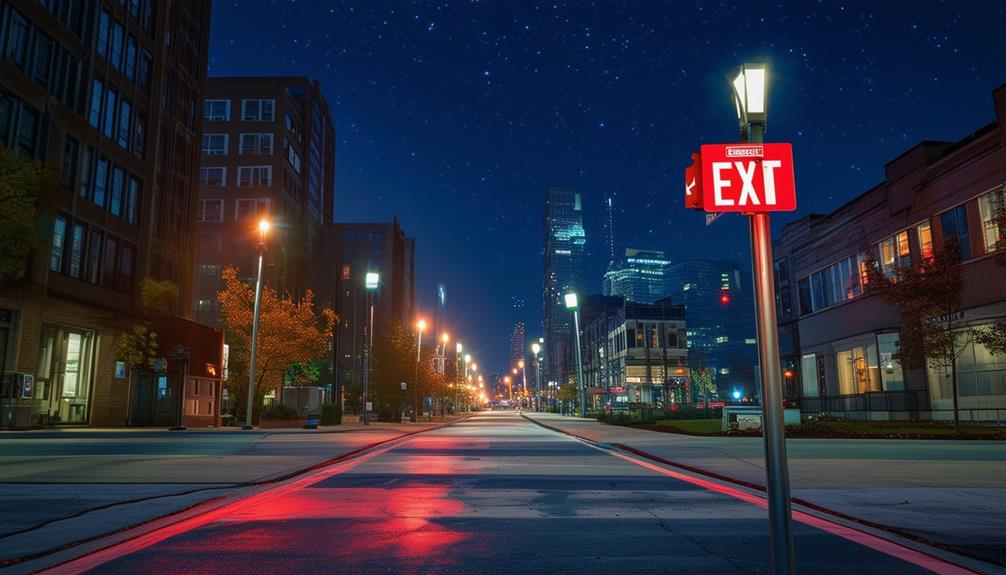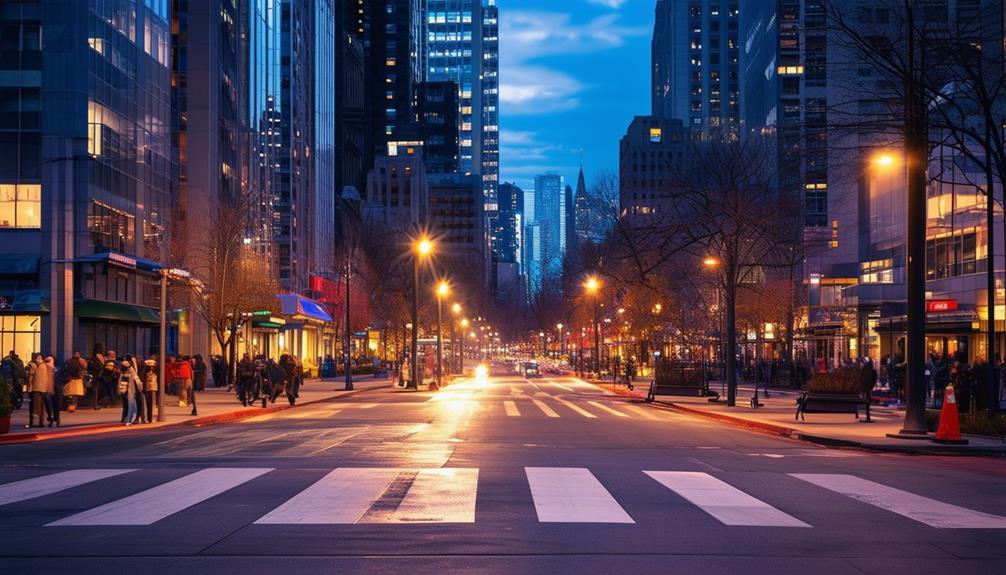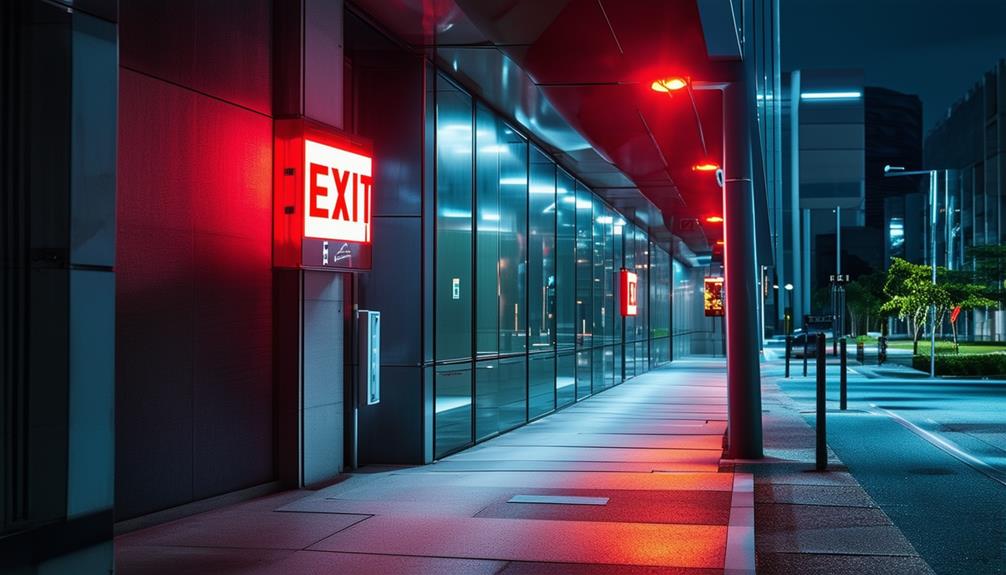The Importance of Emergency Lighting in Urban Areas

Emergency lighting is crucial in urban areas, especially during power outages in high-rise buildings. Without appropriate lighting, panic can set in, making safe evacuation difficult.
Compliance with safety regulations is not just about avoiding fines; it's about saving lives. Emergency lighting ensures that pathways are illuminated and exits are visible, even in complete darkness.
Understanding the specific benefits and regulations of these systems highlights their indispensable role in urban safety.
Regulations Regarding Emergency Lighting

Under the Regulatory Reform (Fire Safety) Order 2005, non-domestic buildings must have adequate emergency lighting to comply with fire safety regulations. Emergency lighting is essential for ensuring the safety of occupants during power outages or emergencies by providing necessary illumination to navigate corridors, stairwells, and exits.
Compliance Requirements
To meet regulatory standards, your emergency lighting system must have a reliable power source. For commercial buildings, a minimum of 1-hour backup power is required. In accommodations such as hotels or dormitories, a 3-hour backup power is necessary. This ensures that emergency lighting remains functional, aiding both occupants and emergency responders during critical situations.
Responsibilities of Building Owners
As a building owner, you're responsible for ensuring that your emergency lighting systems comply with these safety regulations. Regular inspections and maintenance are crucial to ensure the systems are operational and meet required standards. Effective emergency lighting reduces panic and confusion, thereby facilitating a swift and orderly evacuation.
Importance of Compliance
Compliance with these regulations isn't just a legal obligation but a vital measure to safeguard lives. Properly maintained emergency lighting systems contribute to a safer environment for all building occupants. By adhering to these requirements, you demonstrate a commitment to safety and legal conformity.
Emergency Lighting in Public Buildings
Public buildings must have emergency lighting systems to ensure safety during power outages or emergencies. Regulations such as the Regulatory Reform (Fire Safety) Order 2005 mandate these systems to protect public safety. Emergency lights assist in guiding people to exits quickly during crises, reducing panic and aiding fire responders.
Critical areas requiring emergency lighting include stairways, corridors, and exits. Commercial buildings need at least a 1-hour backup power supply, while accommodations require 3 hours. Regular testing of these systems is crucial to ensure they function correctly during real emergencies.
Here is a summary of different emergency lighting requirements:
| Area | Backup Duration | Key Consideration |
|---|---|---|
| Commercial | 1 hour | Frequent testing important |
| Accommodation | 3 hours | Longer backup needed |
| Stairways | 1-3 hours | Clear exit paths |
| Corridors/Exits | 1-3 hours | Easy navigation to safety |
To maintain these systems, consider services like Koorsen Fire & Security, which offer maintenance, testing, and expert advice. Staying compliant with fire safety regulations is not just about avoiding penalties; it is about ensuring everyone can find their way to safety promptly. Functional emergency lighting in public buildings is crucial for safety and compliance.
Benefits of Emergency Lighting

Emergency lighting provides numerous benefits that enhance urban safety and efficiency, beyond ensuring compliance and safety in public buildings. During emergencies such as power outages or fires, emergency and exit lights significantly reduce panic and confusion. In urban settings, the immediate illumination from these lights enables people to evacuate buildings quickly and safely, preventing injuries, stampedes, and fatalities.
Properly installed emergency lighting systems are crucial for effective fire safety. They guide individuals to exits and ensure navigation through buildings even in complete darkness. Moreover, these lights are vital for emergency responders, offering clear visibility to efficiently move through buildings, attend to those in need, and manage the situation effectively.
In addition to facilitating safe evacuations, emergency lights ensure that specific zones remain illuminated to meet safety regulations. This compliance mitigates legal risks and enhances overall public safety. By providing a reliable light source during critical moments, emergency lighting systems contribute to a safer, more resilient urban environment.
Emergency Lighting Systems for Businesses
When establishing emergency lighting systems for your business, it's crucial to adhere to safety regulations to ensure the well-being of all occupants. LED lights provide substantial advantages, such as energy efficiency and durability, making them an ideal option for emergency scenarios.
Regular maintenance is essential to ensure these systems operate effectively in unforeseen circumstances.
Compliance With Safety Regulations
Businesses must ensure their emergency lighting systems comply with the Regulatory Reform (Fire Safety) Order 2005 to enhance occupant safety during emergencies. Adherence to these safety regulations is crucial to guarantee that your emergency lighting system provides adequate illumination in case of a power outage. In densely populated urban areas, where evacuation can be particularly challenging, a well-designed emergency lighting system is essential.
Your emergency lighting system should undergo regular testing and maintenance to ensure it remains functional. Regular testing can identify any faults early, allowing for timely repairs. Maintenance ensures that the system's components are in optimal working condition, thereby reducing the risk of failure during an emergency.
Furthermore, compliance with safety regulations requires commercial buildings to have a minimum of a 1-hour backup power supply, while residential accommodations must have a 3-hour backup. This extended power supply is vital in urban areas where emergency services may experience delays due to traffic or other factors.
Benefits of LED Lighting
LED lighting provides an energy-efficient and reliable solution for emergency lighting systems in commercial buildings. During power outages, LED lights ensure consistent and bright Emergency and Exit Lighting. This reliability is crucial for maintaining safety and preventing accidents during unexpected events.
A key advantage of LED lighting is its energy efficiency. LED emergency lighting systems consume significantly less power than traditional lighting options, leading to lower operating costs for businesses. This not only saves money but also enhances eco-friendliness by reducing energy consumption and environmental impact.
Additionally, LED lights have a longer lifespan compared to conventional bulbs, which means fewer replacements and reduced maintenance needs. This durability ensures that emergency systems remain operational with minimal intervention, aiding compliance with safety regulations.
Integrating LED lighting into commercial building emergency systems enhances overall safety and reliability. Choosing LED for Emergency and Exit Lighting is a smart investment in safety and sustainability, ensuring preparedness for power outages while promoting energy efficiency and environmental responsibility.
LED Lighting in Emergencies

In emergency situations, energy-efficient and durable LED lights can be lifesavers by providing clear visibility in the darkest conditions. LED lighting has revolutionized emergency lights and exit signs, ensuring they aren't only energy-efficient but also highly reliable when needed most.
These lights are designed to guide you safely out of buildings during power outages or other emergencies, adapting seamlessly to various scenarios. LED lights are an eco-friendly option, using recyclable and long-lasting materials. This promotes sustainability while delivering strong performance during critical moments.
The clear visibility offered by LED lights significantly reduces the risk of accidents or disorientation in emergencies, making them essential. Another advantage of LED lighting is its cost-effectiveness. You don't need to replace your entire emergency system to integrate these lights; they can be easily added to existing setups, saving both time and money.
Given their long lifespan and energy efficiency, LED lights are a smart, long-term investment for urban emergency systems. Their growing popularity worldwide underscores their efficiency, reliability, and environmental benefits, making them an ideal choice for urban areas.
Maintenance and Testing
Regular maintenance and testing ensure your emergency lighting systems perform optimally when needed. In urban areas, where power outages and emergencies can disrupt daily life, functional emergency lighting is critical.
Monthly functional testing of battery-powered lights and annual 90-minute tests are essential practices to maintain compliance with safety regulations and enhance the safety and security of your premises.
Visual inspections are crucial for identifying potential issues early. Conducting thorough professional testing confirms that your emergency lighting systems will operate efficiently during emergencies. This proactive approach not only helps you adhere to safety regulations but also provides peace of mind, knowing you're prepared for unforeseen events.
Reliable power sources and regular upkeep of emergency lighting systems are necessary, particularly in densely populated urban areas where quick and safe evacuation is vital. Adhering to maintenance and testing schedules can prevent accidents and ensure your emergency lighting systems are always ready to guide you to safety.
Consistent maintenance and testing aren't just regulatory requirements; they're essential steps to safeguarding lives and property.
Compliance and Safety Standards

Ensuring compliance with safety standards for emergency lighting in urban areas is crucial for protecting public safety and facilitating efficient evacuations. Urban buildings are complex environments, and having reliable emergency lighting helps prevent chaos and injuries during power outages or emergencies.
Adhering to regulations set by organizations such as the National Fire Protection Association (NFPA) and the Occupational Safety and Health Administration (OSHA) is necessary. These standards ensure your emergency lighting systems are up to code, enhancing public safety and evacuation efficiency.
Compliance with these safety standards isn't just about following rules; it's about making urban areas safer and more prepared for crises. Properly maintained emergency lighting systems in urban buildings enable effective navigation and quick evacuations, reducing the risk of panic and harm.
For densely populated areas, this level of preparedness can significantly impact safety during emergencies.
Conclusion
Emergency lighting in urban areas is crucial for safety and security. Compliance with regulations helps mitigate panic and directs people to safety during power outages. Regular maintenance and testing ensure these systems are operational when needed. Modern LED solutions provide efficient and reliable illumination.
The significance of emergency lighting shouldn't be underestimated—it's vital for maintaining safe and secure public spaces and businesses.




